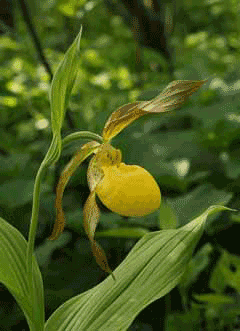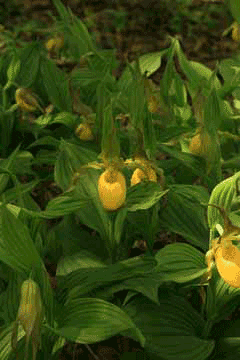 |
|
http://flickr.com/photos/53817483%40N00/ |
 |
| http://flickr.com/photos/53817483%40N00/ |
Translate this page:
Summary
UPDATE 27 March 2012: Cypripedium calceolus var. pubescens (Willd.) Correll is a synonym of Cypripedium parviflorum var. pubescens (Willd.) O.W.Knight
Physical Characteristics

 Cypripedium_calceolus pubescens is a PERENNIAL growing to 0.6 m (2ft) by 0.3 m (1ft in).
Cypripedium_calceolus pubescens is a PERENNIAL growing to 0.6 m (2ft) by 0.3 m (1ft in).
See above for USDA hardiness. It is hardy to UK zone 5. It is in flower in May. The species is hermaphrodite (has both male and female organs) and is pollinated by Insects.
Suitable for: light (sandy), medium (loamy) and heavy (clay) soils. Suitable pH: mildly acid, neutral and basic (mildly alkaline) soils and can grow in very alkaline soils.
It can grow in semi-shade (light woodland) or no shade. It prefers moist soil.
UK Hardiness Map
US Hardiness Map
Synonyms
C. flavescens. C. pubescens. Willd. C. parviflorum pubescens.
Plant Habitats
Edible Uses
References More on Edible Uses
Medicinal Uses
Plants For A Future can not take any responsibility for any adverse effects from the use of plants. Always seek advice from a professional before using a plant medicinally.
Nerve root has a high reputation for its sedative and relaxing effect on the nervous system[238, 254]. The root is a pungent bitter-sweet herb with an unpleasant odour. It was much used by the North American Indians who used it as a sedative and antispasmodic to ease menstrual and labour pains and to counter insomnia and nervous tension[238, 254]. The root is antispasmodic, diaphoretic, hypnotic, nervine, sedative, tonic[21, 46, 165, 192, 222, 238]. It is taken internally in the treatment of anxiety, nervous tension, insomnia, depression and tension headaches[238]. The active ingredients are not water soluble and so the root is best taken in the form of a tincture[222]. The plant is said to be the equivalent of Valerian (Valeriana officinalis) in its effect as a nervine and sedative, though it is less powerful[1, 4]. Another report says that its restorative effect appears to be more positive than that of valerian[254]. The roots are harvested in the autumn and are dried for later use[238]. In the interests of conservation, it is best not to use this herb unless you can be certain it was obtained from a cultivated source - see the notes above under cultivation details[K].
References More on Medicinal Uses
The Bookshop: Edible Plant Books
Our Latest books on Perennial Plants For Food Forests and Permaculture Gardens in paperback or digital formats.

Edible Tropical Plants
Food Forest Plants for Hotter Conditions: 250+ Plants For Tropical Food Forests & Permaculture Gardens.
More

Edible Temperate Plants
Plants for Your Food Forest: 500 Plants for Temperate Food Forests & Permaculture Gardens.
More

More Books
PFAF have eight books available in paperback and digital formats. Browse the shop for more information.
Shop Now
Other Uses
References More on Other Uses
Cultivation details
Succeeds in shade or full sun so long as there is adequate moisture[42]. Grows well in a woodland garden[230]. Plants are best grown on a north or north-west aspect in order to slow down early growth[1]. Requires a humus rich soil with plenty of moisture in the growing season[42], it also succeeds in chalky soils[200]. Must not be planted too deeply[42]. A very ornamental plant[1] it is long-lived when once established, though it is very difficult to establish a plant[233]. The flowers have a soft, rose-like aroma[245]. Plants are growing very well at the Savill Gardens in Windsor[233]. This plant is becoming very rare in the wild due to overcollecting for medicinal usage[238]. Reports that the plant is cultivated for its medicinal uses are largely spurious and, unless you can be certain that the root has come from a cultivated source, it is best not to use this plant medicinally but to use suitable substitutes such as Scutellaria laterifolia and Lavendula angustifolia[238]. Orchids are, in general, shallow-rooting plants of well-drained low-fertility soils. Their symbiotic relationship with a fungus in the soil allows them to obtain sufficient nutrients and be able to compete successfully with other plants. They are very sensitive to the addition of fertilizers or fungicides since these can harm the symbiotic fungus and thus kill the orchid[230].
References Carbon Farming Information and Carbon Sequestration Information
Temperature Converter
Type a value in the Celsius field to convert the value to Fahrenheit:
Fahrenheit:
The PFAF Bookshop
Plants For A Future have a number of books available in paperback and digital form. Book titles include Edible Plants, Edible Perennials, Edible Trees,Edible Shrubs, Woodland Gardening, and Temperate Food Forest Plants. Our new book is Food Forest Plants For Hotter Conditions (Tropical and Sub-Tropical).
Shop Now
Plant Propagation
Seed - surface sow, preferably as soon as it is ripe, in the greenhouse and do not allow the compost to dry out. The seed of this species is extremely simple, it has a minute embryo surrounded by a single layer of protective cells. It contains very little food reserves and depends upon a symbiotic relationship with a species of soil-dwelling fungus. The fungal hyphae invade the seed and enter the cells of the embryo. The orchid soon begins to digest the fungal tissue and this acts as a food supply for the plant until it is able to obtain nutrients from decaying material in the soil[200]. It is best to use some of the soil that is growing around established plants in order to introduce the fungus, or to sow the seed around a plant of the same species and allow the seedlings to grow on until they are large enough to move. Division with care in early spring, the plants resent disturbance[200]. Remove part of the original rootball with the soil intact[200]. Division is best carried out towards the end of the growing season, since food reserves are fairly evenly distributed through the rhizome[230]. Small divisions of a lead and two buds, or divisions from the back (older) part of the rhizome without any developed buds, establish quickly using this method[230]. Replant immediately in situ[230].
Other Names
If available other names are mentioned here
Native Range
Coming Soon
Weed Potential
Right plant wrong place. We are currently updating this section.
Please note that a plant may be invasive in one area but may not in your area so it’s worth checking.
Conservation Status
IUCN Red List of Threatened Plants Status :

Growth: S = slow M = medium F = fast. Soil: L = light (sandy) M = medium H = heavy (clay). pH: A = acid N = neutral B = basic (alkaline). Shade: F = full shade S = semi-shade N = no shade. Moisture: D = dry M = Moist We = wet Wa = water.
Expert comment
Author
(Willd.)Correll.
Botanical References
43200270
Links / References
For a list of references used on this page please go here
Readers comment
| Add a comment |
|
If you have important information about this plant that may help other users please add a comment or link below. Only comments or links that are felt to be directly relevant to a plant will be included. If you think a comment/link or information contained on this page is inaccurate or misleading we would welcome your feedback at [email protected]. If you have questions about a plant please use the Forum on this website as we do not have the resources to answer questions ourselves.
* Please note: the comments by website users are not necessarily those held by PFAF and may give misleading or inaccurate information.
To leave a comment please Register or login here All comments need to be approved so will not appear immediately.
|
Subject : Cypripedium_calceolus pubescens
|
|
|
|